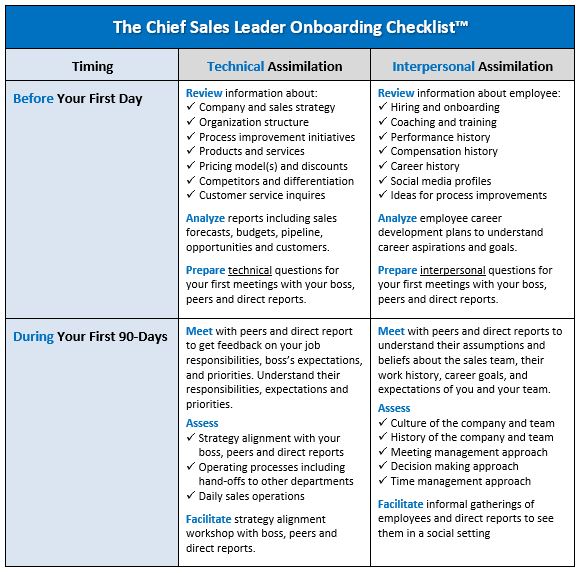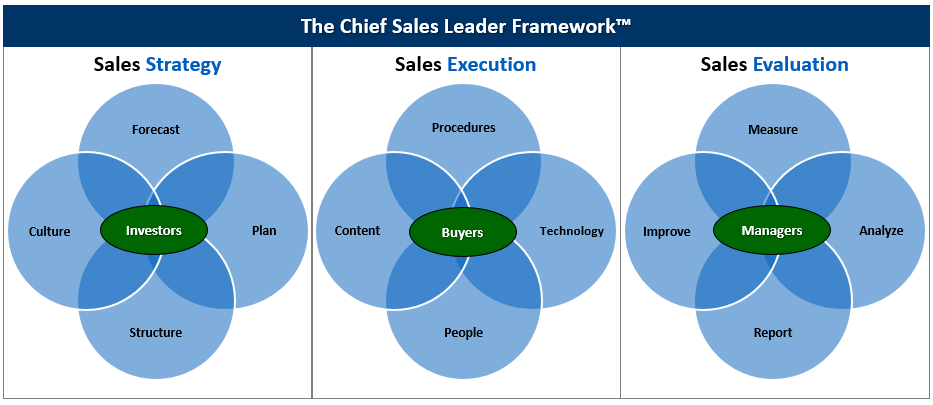Congratulations on Your New Position!
Now it’s time to get to work on your sales manager onboarding plan. Why? Because over 40% of new sales managers (Chief Sales Leader, EVP, SVP, VP, Director or Manager) fail during their first 18 months. Why? There are countless reasons but the most common are:
- Unclear about their bosses’ expectations
- Take too long to learn their position
- Don’t build partnerships and peer relationships to drive teamwork
- Fail to achieve their top two or three objectives
- Lack political savvy
So, the odds are stacked against your success. How can you seize control of your sales manager onboarding process and beat the odds? Let’s explore each failure point and define steps you can take prior to and during your first 90-days.
Failure Point #1 – Unclear About Their Bosses’ Expectations
During the excitement of starting a new sales management position it’s common to lose sight of expectations, responsibilities, and priorities. A recent blog post, What Causes Sales Management Failure?, highlighted that CEO’s expect new sales managers to:
- Sell to cover their cost
- Hire and manage salespeople
- Build an accurate sales forecast
- Install or update the CRM system
- Craft reports to determine if the sales team and people are in or out of control
- Create a sales compensation plan
- Develop sales and market plans
Unfortunately, this is only a partial list of sales management job responsibilities. To make matters worse, there is no textbook or universally accepted framework for building, managing, and improving a sales team. So, each company and new sales manager uses their own approach. Unfortunately, this creates a high-risk, time consuming, and confusing environment for sales manager onboarding.
The good news is that the time-tested Principles of Strategic Management provide a great sales management framework. These Principles define the processes required for a company to execute with precision – – effectively, efficiently, and predictably. Think of it this way. If CEO’s use this framework to run the company shouldn’t sales management use it to run the sales team? For that matter, shouldn’t every department head use it? So, The Chief Sales Leader Framework applies these Principles to sales management.
Step 1 – Prior to your first day, use The Chief Sales Leader Framework™ to clarify job responsibilities, expectations, and priorities. Use it with your boss, peers, and direct reports. If you find conflicts, it’s best to rectify them prior to your first day.
The Chief Sales Leader Framework For Sales Manager Onboarding
This framework defines three strategic processes, twelve operating processes, hundreds of sub-processes, and thousands of tasks, including.
- Strategy – forecasting, planning, organization structure, and culture
- Execution – procedures, people, technology, and information
- Evaluation – tracking, analyzing, reporting, and process improvement
These represent the core job responsibilities of a sales manager. So, this framework provides a great foundation for clarifying your responsibilities, expectations, and priorities. Here are some questions to work through. Which of the twelve operating processes will you have responsibility for managing? Where are you expected to spend time between and within the twelve operating processes? What measures will be used to link your merit pay increases and incentive compensation to these responsibilities?
Click Here to learn more about The Chief Sales Leader Framework.
Failure Point # 2 – Takes Too Long to Learn Their Position
Unfortunately, time is the enemy of sales manager onboarding. From the moment you arrive on your first day, endless meetings and emergent issues will overwhelm your schedule. So, getting work done and generating results will take precedent over sales manager onboarding activities. Before you know it, your first 90-days will be over. How will you find time for?
- Technical Assimilation including learning about company and sales strategy, operations, and measures. This includes initiatives, processes, sub-processes, activities, and tasks. It also includes learning products, services, pricing and discount models.
- Interpersonal Assimilation including learning and honoring the history of your boss, peers, and direct reports. It’s important to understand what makes them tick. What are their assumptions and beliefs, work history, career goals, and expectations? What do they do outside of work? What do they expect from you and your team?
Step 2 – Launch your sales manager onboarding process prior to your first day. Use The Chief Sales Leader Onboarding Checklist™ to define and prioritize your onboarding activities. Without meetings and emergent issues to attend to you can focus on reviewing, analyzing, building lists and preparing questions. If the company is reluctant to share information prior to your first day then work remotely or spend time before and after work during your first few weeks on the job.

Failure Point #3 – Don’t Build Partnerships and Peer Relationships To Drive Teamwork
Building support for the sales team and your initiatives is critical to your success. So, at the end of your sales manager onboarding process will your peers and direct reports support you or block you? Will you be viewed as part of the solution or a continuation of the problem?
A key source of relationship friction are the assumptions and beliefs that people have about revenue growth and sales strategy. How aligned are you with your boss, peers and direct reports on markets served, buyer wants and needs, forecasting, products and services, pricing, organization structure, etc. How about on process improvement priorities and solutions? If you are not aligned with your boss, peers and direct reports you are doomed to fail regardless of how hard you work. Your personal relationships at work will be strained if strategy alignment is low.
Step 3 – Prior to your first day, have your boss, peers and direct reports fill out The Chief Sales Leader Strategy Alignment Questionnaire. This will provide you with insight on their assumptions and beliefs about revenue growth and sales strategy. You can use this information:
- During your first meetings to clarify their perspective and demonstrate that you value their input.
- To facilitate a workshop with your boss, peers and direct reports to gain alignment and buy-in.

Failure Point #4 – Fail to Achieve Their Top Two or Three Objectives
Setting objectives and goals is easy. Simply write them down and share them with your peers and direct reports. But, getting people to execute actions to achieve your objectives is not that simple. Executing actions to achieve objectives requires commitment from your boss, peers and direct reports.
There are four key tools that are used to build commitment to execute actions. So, how aligned are these tools to your objectives?
- Performance Management including job responsibilities, performance goals and compensation.
- Management Reporting including activity and results tracking, analysis and reporting.
- Process Improvement including action plans with specific deliverables, due dates, and owners.
- Sales Procedures and Policies including removing barriers and bottlenecks that block
Step 4 – During your first week, meet with your peers and direct reports. Share and get their feedback on your job responsibilities, boss’s expectations and priorities. It’s also important to understand their responsibilities, expectations and priorities. Within your first 30-days facilitate a revenue growth and sales strategy alignment workshop to get your boss, peers and directs on the same page.
Failure Point #5 – Lack Political Savvy
So, you clearly have the sales and sales management expertise to lead the sales team to the next level. But are you astute enough to figure out who the key company influencers are? Do you have empathy toward others work, career aspirations, and personal life? Will your peers and direct reports view you as manipulative or as a genuine leader?
During sales manager onboarding focusing on getting work done and learning the technical aspects of the business is critical. Unfortunately, this can be costly to your career. So, how will you navigate company culture and politics?
- Company History including the vision, purpose, values, goals, heroes, villains, key dates in history, etc.
- Decision Making Approach including understanding the companies approach i.e. centralized vs. decentralized, authoritarian or collaborative, etc.
- Meeting Management style including the company’s approach to setting and following agendas and time management i.e. arriving early or late for meetings, leaving early, etc.
- Career Development Plans including helping each of your direct reports understand their career aspirations, define an action plan, and monitor steps toward achieving their dreams.
- “Water Cooler” conversations including understanding the working environment, connections between people and company norms and behaviors.
Step 5 – Prior to your first day, review company history documents and ask your boss for insight on the items above. During your first meetings with your peers and direct reports ask them for input on these items. Steer clear of company politics and gossip. Focus on investing in the success of your boss, peers and direct reports and they will invest in yours.

Conclusion On Sales Manager Onboarding
With the odds stacked against you, seizing control of your sales manager onboarding process is critical. Taking the following steps prior to your first day and during your first 90-days will help you beat the odds:
- Clarify your job responsibilities, boss’s expectations and priorities prior to your first day.
- Review and analyze key documents so you can build lists and prepare questions prior to meeting with boss, peers and direct reports.
- Assess the level of revenue growth and sales strategy alignment you have with your boss, peers and direct reports. Have them fill out a strategy review questionnaire so you can gain specific insight on disconnects . During your first 30-days facilitate a strategy alignment workshop to get everyone on the same page.
- Ensure that performance management, management reporting, process improvement, sales procedures and policies are focused on achieving your top two to three objectives.
- Strive to understand company and sales team culture and avoid company politics and gossip.
Just remember – – from the moment you arrive on your first day, endless meetings and emergent issues will overwhelm your schedule. Getting work done and generating results will take precedent over sales manager onboarding activities.
So, get started prior to your first day. Review and analyze information, build lists and prepare questions. If the company is reluctant to share information prior to your first day then work remotely for the first few weeks or spend time before and after work. Invest in your boss, peers and direct reports and they will lead you to success.
Before you know it, your first 90-days will be over. So, seize control of your sales manager onboarding process!
Please Take a Minute To:
- Write a comment on this post
- Click Here to learn more about The Chief Sales Leader Framework
- Share this blog with other sales leaders, salespeople, CEO’s and investors
It’s time to bring precision – – effectiveness, efficiency, and predictability – – to sales execution.


